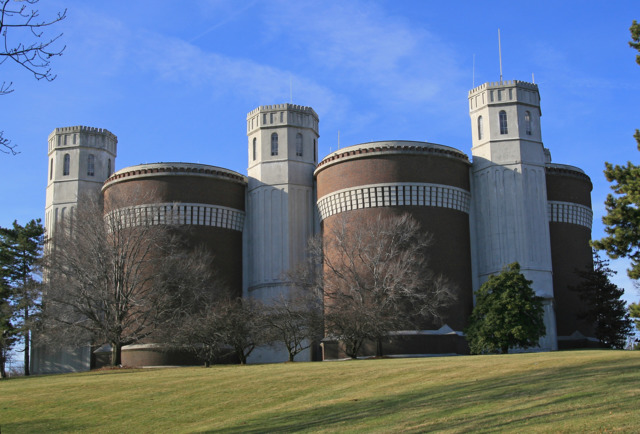A few months after it looked like parts of the iconic Mt. Airy water towers might be demolished, the structure — in its entirety — is now in the final stages of securing local historic landmark status.
Initially, Greater Cincinnati Water Works said it would need to reduce water capacity in the 8.3 million-gallon facility and remove three of seven of its distinctive tanks and two of six of its concrete towers due to ongoing deterioration. But after community feedback, it has revised those plans to keep the entire structure intact.
Now, the towers look likely to get some extra protection.
After approval last month from the Cincinnati Historic Conservation Board, on Nov. 16 the city’s Planning Commission also approved an application from the Mt. Airy Town Council to designate the water towers as a local historic landmark, a classification that gives the structures some protections and sets guidelines for any planned alterations.
In May this year, Greater Cincinnati Water Works announced it was looking at plans to rehab the towers while reducing their capacity by 50 percent. Two of the three options GCWW presented in public forums included tearing down portions of the distinctive, castle-like towers.
That caused plenty of concern from many in the neighborhood and beyond.
Why the fuss about the water towers? The 90-year-old structures are a big deal for a few reasons. First, the seven six-story tanks and six seven-story towers (one of which houses a staircase) sit 962 feet above sea level on the highest point in Cincinnati. When they were built in 1927, they represented the first municipal water source for a number of west side Cincinnati communities, including Cheviot, College Hill, Mt. Airy, North Fairmount, Price Hill and other nearby neighborhoods, which had previously gotten water from cisterns. The reliable water supply helped spur development of those areas.
Then-Water Works Commissioner J.A. Hiller designed the structure. The towers are said to be a nod to another historic Cincinnati landmark — the Elsinore Arch that welcomes visitors to Eden Park, which was completed in 1883. That arch, built as part of the reservoir that used to occupy the park, was the first project by the city’s Water Works to use the distinctive castle-like architecture. The Mt. Airy Towers were the last.
The towers are iconic enough that they’ve become the symbol used by the neighborhood’s community council and other civic bodies to represent Mt. Airy.
But over the years, the facility has seen some wear and tear. It requires repairs all along its foundation and much of its masonry and concrete also needs to be fixed.
After meetings this spring about the original rehabilitation plans calling for demolition of some of the towers led to negative feedback, GCWW went back to the drawing board. A number of Mt. Airy residents, including former Cincinnati City Councilman Kevin Flynn, got involved and helped convince Water Works to change its plans.
“In consideration of this feedback and subsequent meetings, GCWW undertook further evaluation to address community and historic preservation concerns, in unison with structural needs and operational requirements,” reads an Oct. 3 letter from GCWW Director Cathy B. Bailey to acting Cincinnati City Manager Patrick Duhaney. “The outcome of the re-evaluation has modified the original concept of the rehabilitation project from that originally proposed. The GCWW project plan now includes rehabilitation of the full facility façade, thereby maintaining the current footprint of the structure.”
GCWW says it will be possible to make needed repairs and adjustments to the towers without sacrificing its appearance, though that will cost more. The original rehabilitation project was estimated to run $7.7 million. The new plans will cost an estimated $10.4 million.
In the meantime, the historic landmark designation isn’t a done deal yet. Cincinnati City Council must give final approval.


